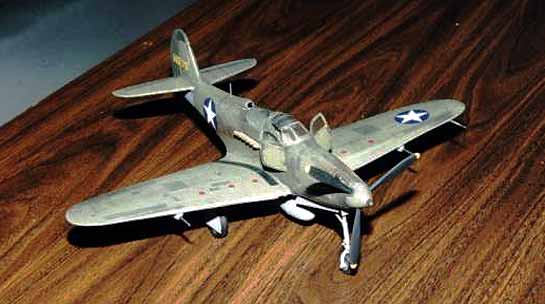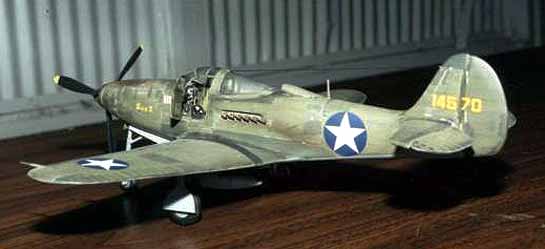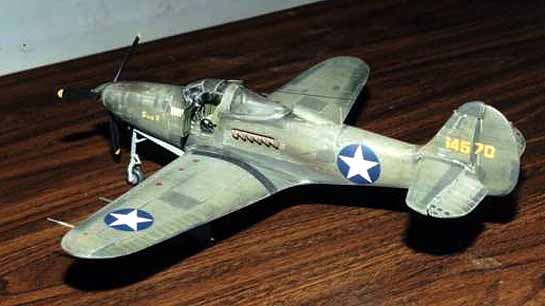Combat Models 1/32 P-39
By Larry Hawkins

This was the first release from the guy that originally owned Combat Models before John got it. It's as all vac kits, basic, but when these first time vac kits came out, they had parts like a prop, instrument panel, gear legs and decals. I couldn't believe that I got this kit for $15.00 when the new edition is $32.95 and they don't come with anything but the vac parts.
Well, as I do with all my vac kits, I scribe around and sometimes cut out the pieces off the sheet they come on. After all the parts have been cut out, I take my sand board that has a piece of 150 grit sandpaper and start the process of sanding down the parts to their right shape and size, fitting and refitting the parts before I start gluing them together. I sand all the parts down after this is done. I started with the wings because they went together really well and I few problems other than cutting out the vents on each wing, four in all. After these were shaped and sanded to the leading edge, a final sanding was given to the entire wing, when this was done they were set aside.
The tail plane was a whole other deal. The kit elevators were too thin and didn't look right, so I had some spare elevators from the hellcat kit from Hasegawa. This kit comes with the two different types to make the 3 or 5 mark # F6F. These were glued together and cut to shape then sanded down and rescribed per the plans that come with the kit. Had to cut off the rudder, because it was didn't look right, and this was reshaped and then glued in to place, but this was done after the cockpit was scratched and painted before the fuselage halves were glued together. I let this sit for a whole day to let the paint and other stuff dry.
Now came time for gluing and setting the wing section into place, this was easy to say the least. I used one tube of super glue here. Gaps—not bad but using super glue with an accelerator is magic when building vacs, or just about any model you're working on. I then proceeded to whip up some autobody putty to fill the gaps that were still visible. This was left to dry for 24hrs. When using this one must let the putty cure regardless; it tends to lift off the plastic which is good sometimes but bad others.

After all the putty had dried, it was time for sanding and working the putty to shape, it doesn't take long before you start seeing results.
I went slow here because in the past I have got a little carried away and sanded through the plastic—bad form. When all the sanding was done and it was looking more like a P-39, I went to the other parts and started getting them ready for the final touch, this was detailing the doors. I cut them both out to give maximum viewing.
When everything was done and ready for paint, I started to mask the cockpit off and this took about 2 hrs. It's not the easiest canopy to mask, don't want any over spray, if you know what I mean. I then wipe down the whole plane with lighter fluid, this will wash off fingerprints and anything that shouldn't be there. I scratchbuilt the spinner from the 109 kit from Hasegawa, that supplied with the Combat kit was again, incorrect. It was reshaped with putty and the cannon was added later after all the sanding and smoothing was done.
This model was sprayed with a can, primer wise, then let dry. I let it set for two days then it was time for the O.D. top coat, I chose to hand paint it. This is a habit I picked up a long time ago when one's compressor blows up and all the funds are invested in the kits I have. I first applied the O.D. that I mixed up from stuff I had laying around and when I got the color that I was looking for then I went at it. After the O.D. had dried thoroughly, I added areas of worn paint and different panels that showed the wear and tear on this A/C. One thing I forgot to mention was that the landing gear was from the Revell P-51 kit and it was also modified to fit the P-39.I also used the monogram P-51 in 32nd scale, had one laying around for about 20 years. It was my first one when I was a kid. They fit well and were the same size and width as the plans.
When all was dry and ready for the next step, I went over places that cracked paint and used masking tape to pull it up and it showed the white plastic, this was over painted with silver and a fine brush to give it paint chips in the areas of the panels, after this I gave the entire plane a black acrylic wash, and after this, the whole plane was rubbed down and checked to see if any place was not washed but should have been. Then the decals were added and let dry with decal set. The final step was a flat coat out of the can. When dry I added the nav lights and the antenna wire that was stretched sprue.

All in all, it took two weeks to do this. An hour here and 4 hours there. And the weekends, all the time I want.
© Larry Hawkins
This article was published on Wednesday, July 20 2011; Last modified on Saturday, May 14 2016
